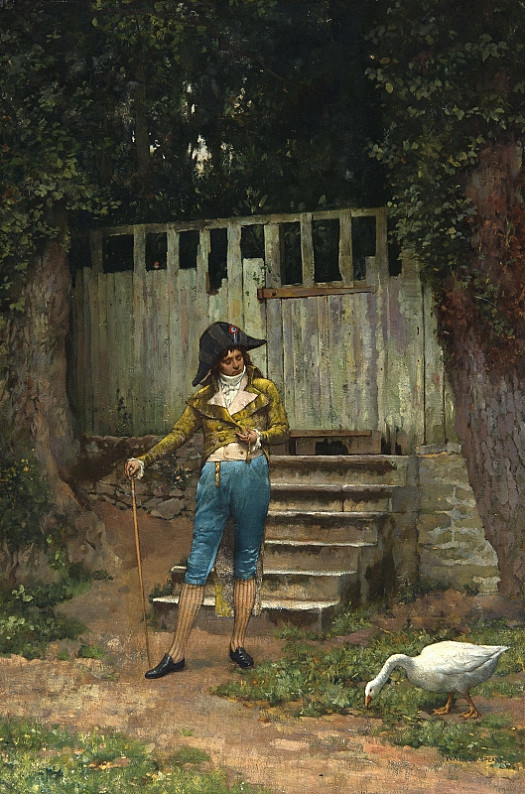William Breakspeare was born in Edgbaston, Birmingham, on 19 January 1856, the second son, and second of five children, of John Breakspeare and his wife, Emma (née Hawkes). John Breakspeare was employed as a flower painter in the Birmingham japanning trade, which, locally, had risen rapidly to the height of its success by the mid nineteenth century.
William was subsequently apprenticed as a decorator to the japanning firm, Halbeard and Wellings. In the census of 1871, he is listed as a ‘flower painter’, as is his father. His eldest brother, John, became a musician and is recorded as a ‘Professor of Music’, possibly leaving William to follow in their father’s footsteps.
After completing his apprenticeship, Breakspeare undertook formal artistic training, enrolling at the Birmingham School of Art in 1877. It proved to be a particularly formative period for him. He discovered his talent as both a draughtsman and painter, and became acquainted with a wider artistic circle, many of whom would become lifelong friends and colleagues, including Edwin Harris (who features in Chris Beetles Summer Show, 2017, page 90-91). In 1879, both Breakspeare and Harris became founding members of the Birmingham Art Circle, the first secretary being Walter Langley, who would become an influential fellow member of the Newlyn School. In 1881, whilst at the Birmingham School of Art, Breakspeare won ‘the highest reward’, a gold medal, in the Academies and Institutes National Competition of the Works of Schools of Art, for his ‘oil-painting of figure from the nude’. The painting was praised in a review in The Artist and Journal of Home Culture: ‘The light and the shaded portions are cleverly managed, and the execution bold and vigorous in handling’.
Following his education in Birmingham, Breakspeare spent time in London and in Paris, where he fell under the influence of Thomas Couture. In 1881, he and Harris were listed as visitors at the White Swan, St Martin-in-the-Fields, London. They remained close both personally and professionally, and would both study under Charles Verlat at the Academy in Antwerp in the early 1880s. Breakspeare began exhibiting at the Royal Society of British Artists in 1882. Three paintings are listed for that year, and hint at his prolific future career: Une Petite Blanchisseuse, A Little Housewife and Une Merchante Enfant.
After Antwerp, Breakspeare continued to travel on the Continent, visiting Venice in 1883. His contemporary, Frank Bramley, who also studied under Verlat at the Academy in Antwerp and would become a fellow member of the Newlyn School, was in Venice during this period. He wrote home to William John Wainwright that Breakspeare ‘was working hard on the small island of Burano (Bay of Venice) and liked Venice very much.’ The ‘Birmingham Boys’, as they are often known, became the founding fathers of the Newlyn School, which championed painting en plein air and the employment of natural light. In 1884, Frank Bramley and William Breakspeare both appear in a photograph of the members of the Newlyn School.
Upon his return from his European tour in the late 1880s, Breakspeare established himself in London, first exhibiting at the Royal Academy in 1891. From around this time he settled in Hampstead, at 1 The Mall, also known as the Mall Studios. However, he remained loyal to his native Birmingham. Elected a member of the Royal Birmingham Society of Artists in 1884, he continued to show there until 1899, 34 works in total. A prolific exhibitor, he also showed 21 works at the RA, 52 at the Royal Institute of Painters in Oils, 18 works at the RBA, as well as 98 at the art dealer, Dowdeswell. He is also known to have exhibited at the Royal Manchester Society (1887), the RI and the Grosvenor Gallery.
His success continued to grow and reflected his impressive output. However, despite his experience of training and working on the Continent, he was not keen to exhibit at the Venice Biennale in 1898. The Biennale Secretary, Antonio Fradeletto, wrote in response to Breakspeare’s declining the invitation: ‘Your letter from the 6th caused me great pain … I would be very sad not to have it [Memories] in Venice. Please let me insist for you to send it indeed’.
Throughout the 1890s, Breakspeare became increasingly well known, and though he is often remembered for his eighteenth-century genre scenes, such as the present work, his style and subject matter were diverse. The pictures that he produced in the early 1880s are notable for their simplicity. Portraits such as The Maidservant (Tameside Museums and Galleries) hint at his direct skill as a draughtsman and painter. A great number of works were inspired by his travels on the Continent. Such paintings as A Venetian Beauty (Russell-Coates Art Gallery & Museum, Bournemouth) suggest an amalgamation of his talents as a portraitist with a Pre-Raphaelite influence that would fully emerge in classical genre paintings such as View of a Maidservant before a Feast. In many instances, his paintings depict literary or classical subjects that were fashionable at the time, such as Tennyson’s The Lady of Shalott. However, his later work took on an orientalist influence, as is evident in Odalisque. Despite his versatility, his success was consistent throughout his career. In 1904, in The International Studio, a critic wrote: ‘Mr W A Breakspeare has for years enjoyed the reputation of having a distinguished sense of colour in figure-work and clever execution. His nudes are refined, and his drawing is wonderful in its accuracy and apparent simplicity’.
William Arthur Breakspeare never married and died at home, in Hampstead on 8 May 1914.


